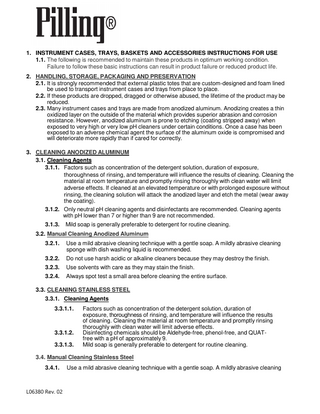3 Pages

Preview
Page 1
1. INSTRUMENT CASES, TRAYS, BASKETS AND ACCESSORIES INSTRUCTIONS FOR USE 1.1. The following is recommended to maintain these products in optimum working condition. Failure to follow these basic instructions can result in product failure or reduced product life. 2. HANDLING, STORAGE, PACKAGING AND PRESERVATION 2.1. It is strongly recommended that external plastic totes that are custom-designed and foam lined be used to transport instrument cases and trays from place to place. 2.2. If these products are dropped, dragged or otherwise abused, the lifetime of the product may be reduced. 2.3. Many instrument cases and trays are made from anodized aluminum. Anodizing creates a thin oxidized layer on the outside of the material which provides superior abrasion and corrosion resistance. However, anodized aluminum is prone to etching (coating stripped away) when exposed to very high or very low pH cleaners under certain conditions. Once a case has been exposed to an adverse chemical agent the surface of the aluminum oxide is compromised and will deteriorate more rapidly than if cared for correctly. 3. CLEANING ANODIZED ALUMINUM 3.1. Cleaning Agents 3.1.1. Factors such as concentration of the detergent solution, duration of exposure, thoroughness of rinsing, and temperature will influence the results of cleaning. Cleaning the material at room temperature and promptly rinsing thoroughly with clean water will limit adverse effects. If cleaned at an elevated temperature or with prolonged exposure without rinsing, the cleaning solution will attack the anodized layer and etch the metal (wear away the coating). 3.1.2. Only neutral pH cleaning agents and disinfectants are recommended. Cleaning agents with pH lower than 7 or higher than 9 are not recommended. 3.1.3.
Mild soap is generally preferable to detergent for routine cleaning.
3.2. Manual Cleaning Anodized Aluminum 3.2.1.
Use a mild abrasive cleaning technique with a gentle soap. A mildly abrasive cleaning sponge with dish washing liquid is recommended.
3.2.2.
Do not use harsh acidic or alkaline cleaners because they may destroy the finish.
3.2.3.
Use solvents with care as they may stain the finish.
3.2.4.
Always spot test a small area before cleaning the entire surface.
3.3. CLEANING STAINLESS STEEL 3.3.1. Cleaning Agents 3.3.1.1.
3.3.1.2. 3.3.1.3.
Factors such as concentration of the detergent solution, duration of exposure, thoroughness of rinsing, and temperature will influence the results of cleaning. Cleaning the material at room temperature and promptly rinsing thoroughly with clean water will limit adverse effects. Disinfecting chemicals should be Aldehyde-free, phenol-free, and QUATfree with a pH of approximately 9. Mild soap is generally preferable to detergent for routine cleaning.
3.4. Manual Cleaning Stainless Steel 3.4.1.
L06380 Rev. 02
Use a mild abrasive cleaning technique with a gentle soap. A mildly abrasive cleaning
sponge with dish washing liquid is recommended. 3.4.2.
For disinfection follow the instructions of the disinfection chemical manufacturer for stainless steel
3.4.3.
Use solvents with care as they may stain the finish.
3.4.4. Always spot test a small area before cleaning the entire surface. 3.5. Mechanical Cleaning of Stainless Steel 3.5.1.
Follow the cleaning equipment manufacturer’s instructions and recommended cleaning agents for Stainless Steel parts.
3.6. STERILIZATION 3.6.1. Our trays are meant to provide protective containment of surgical instruments and other medical devices during transportation and storage. Our trays are reusable and can be steam sterilized using autoclave. Time and temperature parameters required for sterilization vary according to type of sterilizer, and packaging material. 3.6.2. Always verify parameters with sterilizer manufacturer’s written instructions. 3.6.3. Proper handling, loading and unloading of trays for steam sterilization: 3.6.4. It is not recommended to load trays on their sides or upside down with lid side down on shelf or cart. Load cases on cart or shelf so that the lid is always facing upward. This allows for proper drying. Overcrowding of trays during autoclaving must be avoided. 3.6.5. After the autoclave door is opened, all trays should be allowed to cool to room temperature before handling. The amount of time required depends on load content and ambient conditions (temperature and humidity. 3.6.6. If wet spots on the packaging are observed, the contents must be treated as non-sterile and be thoroughly reprocessed. 3.6.7. If condensation is observed, check to ensure that recommendations 3.6.1. and 3.6.2. were followed. Also, verify that the steam that is being used for sterilization processing has a quality of more than 97%. Confirm that the sterilizers have been inspected for routine maintenance in accordance with the manufacturer’s recommendations. 3.7. Glossary- Explanation of Symbols
L06380 Rev. 02
L06380 Rev. 02